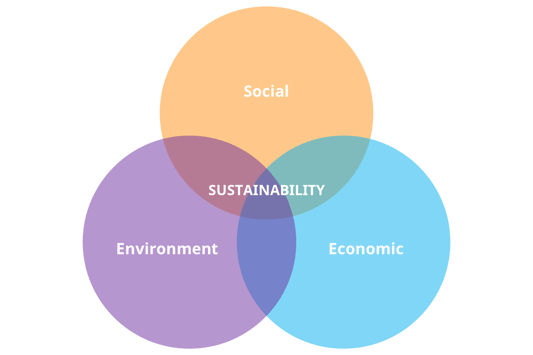Can Environmental Compliance Fuel Innovation?
Not to sound dramatic, but the Earth is on fire.
NGOs and activists are pushing harder than ever to rescue at least a scrap of untouched forests for the future generations. Governing bodies are scrambling to implement more regulations and laws with an effort to undo decades of environmental damage. On top of that, we are witnessing mental shift in society with more people joining sustainability movements, choosing environmentally friendly products and responsible companies. And for companies, it is becoming obvious that business as usual will not cut it anymore.
In today’s article I will take a better look at what sustainability and sustainable innovation means, how environmental compliance goes hand in hand with it and finally, how several global leaders used this trifecta to fuel innovation, growth, and disruptive change.
Perhaps we can all learn from these examples of how (and why) sustainability and environmental compliance could (and should) be at the forefront of innovation.
Table of contents
Compliance, be it environmental or not, does not have the best of reputation and perhaps it can be hard to imagine it as a fuel to innovation, quite the contrary. Laws and regulations bring up the image of constraints, penalties and additional expenses, and it is hardly viewed as enabler.
Likewise, sustainability can also come off wishy-washy. “There is a crippling vagueness about what sustainability means,” Geoffrey Jones, a professor at Harvard University told PBS News Hour.
Not only does the lack of understanding make it difficult to hold a business culpable in case of an incident, but it also makes it hard to commit to quality sustainability.
In addition, the absence of credible sustainability standards and definition, hinders the companies’ opportunity to market their production as green, as it can come off as greenwashing.

Sustainability and Sustainable Innovation
In 1987, the United Nations (UN) Brundtland Commission defined sustainability as “meeting the needs of the present without compromising the ability of future generations to meet their own needs.
Quite often the term sustainability and the above definition is applied and associated with environmental change, and it makes sense as the decisions made by our predecessors caused it. However, today it is agreed that it’s equally as important to look at the other two legs of sustainability – social and economic issues.

When I think of sustainability, I tend to lean towards the definition offered by The University of California, Los Angeles (UCLA) Sustainability Committee:
the integration of environmental health, social equity and economic vitality in order to create thriving, healthy, diverse and resilient communities for this generation and generations to come.
Thus, sustainability is more than ecological questions, it is a systemic approach to all three areas.
To think of sustainability as a reduction of plastic used, slashed carbon emission or recycling is not wrong. All these aspects fit neatly under one umbrella. However, sustainability should create a positive impact for the planet and all your stakeholders: employees, customers, suppliers, and as UN accurately points out – future generations too.
Sustainable innovation makes sustainability possible. It is all about the intentional decisions regarding companies’ products or services to support social and environmental wellbeing while creating profit.
However, it can be a hard concept to grasp and bring into practice. But, as Professor Andrew Hargadon puts it, you can also think of it simply as introducing
new products and processes that are more sustainable than current alternatives (consuming less resources, fostering health and are affordable for consumer and producer alike).
At the pace of environmental change we are experiencing, and new regulations being introduced, it is safe to say that no one will avoid the topic of sustainability. Sooner or later every business, no matter the sector, will be impacted. Most of them – indirectly.
Essentially, you will not drown in the rising oceans or get crushed by crumbling ice caps. It’s the shift in market preferences, new technologies and changing consumer habits that will end up (or actually – already is) affecting you. To keep up, sustainable innovation is playing a major role.
Differences to Be Aware of
Sustainable innovation is not the same as sustaining innovation. In short – sustaining innovation occurs when the product is made slightly better with every iteration, eliminating defects.
Whereas sustainable innovation, as A. Hargadon offers, is the development of new products or processes that consume fewer environmental resources. However, both go hand in hand. As we will see in the examples section, a single innovation does not change the market or organization overnight. These companies used sustainability and environmental compliance to shape and improve their processes until they became global leaders.
However, it is important to emphasize that not all sustainable decisions are equal to innovation and vice versa.
Opting for ceramic mugs instead of plastic cups in the break room is a great effort to reduce plastic consumption, yet it isn’t innovative.
On the other hand, coffee pods that reached all time popularity in the recent years is a brilliant innovation. Unfortunately, recycling solutions or reusable options came late, not before the coffee pods piled up in landfills, hence it wasn't sustainable.
True sustainable innovation lies somewhere in the middle, and it is up to each business to find that unique sweet spot. After all, the world isn’t suffering from the lack of fantastic and brave ideas, rather the issue is finding the right time and place to deliver them.

Environmental Compliance
The compliance definition is more straightforward than the one for sustainability. Cambridge Dictionary sums it up sweet and short: as an act of obeying an order.
In this article, when I talk about being compliant, I am thinking of the regulatory compliance which is an organization’s adherence to state, federal and international laws and regulations, depending on the field of operations.
However, as the key focus in this article is sustainability, let’s take a deeper look at one particular area of regulations: environmental compliance.
Environmental compliance leans into the environmental leg of the sustainability trifecta and it means conforming to environmental laws and standards, put in place by governing bodies. It encompasses international and local efforts to fight climate change, and addresses other severe issues such as water shortage and marine pollution.
Environmental compliance is a tricky topic. While the majority understands the need for it and for tighter regulations to protect what we have for future generations, we sometimes still witness some pushback from certain groups.
Also, there are numerous examples of countries pulling and shoving at environmental laws all at the same time – claiming to protect the biodiverse ecosystems, yet destroying it with mining and oil extraction. In this scenario, profit now wins over the long-term goals and UN’s vision of the future.
Despite the most obvious reasons and the need for environmental compliance, there are a couple of intangible points worth mentioning.
First, we live in an era of hyper-connectivity. A smallest slip up, intentional, or not, can be broadcasted to thousands of people in a matter of seconds. Lax view on compliance can turn costly. There’s little time to plan in advance when talking about reputational risks and with tight competition creating an overflow of options to choose from, you can quickly lose customers.
Second, questions of sustainability and ethical conduct are receiving more spotlight. People are getting educated and at the same time, social media is influencing people’s buying habits by promoting sustainable, green options and also by talking about social injustice. Lack of integrity beyond laws, disregard to human rights in manufacturing or lack of data to support your green claims can be destructive to your image.
Let’s quickly recap what has been covered so far. Sustainability is (becoming) an inseparable part of business development and sustainable innovations are the key to reach it. And finally, this is the space where environmental compliance comes into play. When you are struggling to find space for sustainable innovation, you can lean into compliance to fuel it.

Examples of Innovation through Environmental Compliance
Isn’t it quite a curious paradox that many people still believe in infinite growth on a finite planet?
Today we already know that that does not work, we know that we’ll all have to do more and better with what we have.
The path to be taken differs for each industry and especially for such traditional businesses as food and agriculture, heavy manufacturing, and energy companies. Their business models don’t price in externalities, such as emissions, nor were they built with a sustainable mission and vision in mind, as an increasing number of green start-ups and newly founded companies are.
Before we continue to the examples section, I feel obliged to point out few things.
Introducing recycling options does not mean that a business isn't mindlessly consuming non renewable materials. Using natural or plant based materials does not guarantee zero damage to the environment. Divesting from a polluting business does not eradicate it or it's negative effects to the environment. And finally, creating a sustainable product without a feasible upcycling or recycling option, does not assure sustainability in a longer run.
While the below mentioned companies have achieved great results and are making a positive impact today, we must remember that they are not perfect.
Hewlett-Packard
Over the last few decades, Hewlett-Packard, better known as HP, proved to be a pioneer in sustainable innovation.
In the late 80’s, lead toxicity (it causes irreversible damage to developing children, can contaminate water supplies and harm plants and animals) was too obvious to be ignored and by 1986 lead solder was banned by the US in plumbing systems. HP realized that it is only matter of time when the same alloy will be banned from electronic production too. They used this foresight to experiment with different materials and were able to come up with just as efficient, lead-free solders and became one of the first companies to fully comply with the EU’s Restriction of Hazardous Substances Directive back in 2006.
While other companies were still scrambling to find best fitting solutions and compliant suppliers, HP were able to present and market ready and lead-free products.
In a similar fashion, HP found a business opportunity in EU’s Waste Electrical and Electronic Equipment (WEEE) regulations, requiring hardware manufacturers to cover a chunk of recycling costs in proportion to their sales. Predicting high costs for a government-sponsored recycling programs, HP joined forces with three major electronics manufacturers (Sony, Braun-Gillette, Electrolux) and established a private European Recycling Program (ERP).
Not only did HP lowered their possible expenditure on recycling, but the company also improved their reputation and trustworthiness within the industry, consumers, and the policy makers.
HP used time, effort and resources to research and predict possible changes in their industry. Instead of harboring their insights, lobbying against incoming environmental regulations, the company focused on creating and sourcing new alloys, chemical compounds and most importantly they joined forces with their competitors to find better solutions. While all the company’s achievements could be written off as self-serving (fine avoidance, money saving etc.), thanks to them the planet is a little cleaner, people – healthier.
Neste
It might sound dubious to put the name of a company that once started as a traditional oil refinery, in the same sentence with sustainable innovation and green technology. However, as of today, “85% of Neste’s profits come from their renewable diesel segment”.
Neste, a Finnish oil refining and marketing company, made numerous, consecutive appearances in the Corporate Knights Global 100 Index of the most sustainable companies in the world. During this time, the company has been completely redefining what a traditional oil business looks like. Although Neste is still profiting from their oil refinement segment and service stations, today the company is the world’s largest producer of renewable diesel.
Recent decades witnessed a rapidly increasing number of environmental regulations aiming to cut down CO2 emission. EU is a leading force behind these incredibly ambitious plans with Ursula von der Leyen, chief EU Commission stating that EU’s political commitment to becoming the first climate neutral continent by 2050 has become a legal one. Neste on the other hand has committed to following Finland’s goal of reaching carbon neutrality by 2035.
"We are acting today to make the EU the world's first climate neutral continent by 2050. The Climate Law is the legal translation of our political commitment, and sets us irreversibly on the path to a more sustainable future."
- Ursula von der Leyen, President of the European Commission
With this background, Neste seized an excellent opportunity to grow in a completely new field – renewable fuel. The company was able to move over half of their assets to sustainable market.
Today Neste chooses to work mainly with industry waste (oil refinement and production waste and residues) and sustainably produced vegetable oils as raw material, instead of non-renewables. They have long have placed innovation as one of their key missions and this allows Neste to be one of the only companies capable of utilizing these lower grade materials as ingredients.
Such foresight and agility in the face of regulations gives Neste a competitive edge in catering other industries too. In 2020 the International Maritime Organization (IMO) implemented new regulations limiting the amount of sulfur in ships’ oil (“with benefits for the environment and human health from a reduction in sulfur oxides in the air”).
Back in 2019, when the IMO was just starting the talk of the impeding regulations, Neste already had a solution for the shipping industry, offering their new, compliant marine fuel.
Neste is rewriting the course of their history by leaving the old-school oil refinement work behind and delivering solutions to fight climate change. By making ESG (environmental, social, governance) compliance and sustainability their business goal and mission, they were able to become undeniable market leaders.

Ørsted
Ørsted, Danish power company, has been ranked as one of the world’s most sustainable energy company since 2019. It’s quite difficult to imagine that a company as green as Ørsted used to be one of the biggest pollutants in Denmark, contributing to one third of all the CO2 produced in the country.
However, realization of the impact it creates, the desire to be relevant and competitive, and above all – increasing number of environmental regulations made it clear that Ørsted couldn’t continue with the same business approach.
The fight of the government and NGOs against air pollution meant that many of the company’s operations would be limited, taking away their biggest revenue streams. Thus in 2009 Ørsted started a transition towards sustainability with the aim of generating 85% of power from renewable sources. Their initial goal was to reach this feat by 2040. However, drastic and aggressive measures enabled the company to reach said goal by 2019, hitting the goal a total of 21 years ahead of planned schedule.
In an interview with McKinsey, the CEO of Ørsted’s offshore-wind business, Martin Neubert stated that renewable energy agenda positioned by UN at the 15th Conference of the Parties (COP15) received strong support from the Danish government. This governmental position influenced and redirected the company’s approach towards the future of their energy production.
In a similar fashion to Neste, Ørsted placed their focus on one key business function – offshore-wind power. They divested oil and gas businesses and invested heavily in innovation and the development of better, more efficient wind turbines, becoming a global leader in harnessing offshore-wind power and taking control of 30% of the global market.
Tesla
As Tesla is a green energy business, manufacturing solar panels, battery energy storage solutions and most famously – best-selling electric vehicles (EV), the company is an impressive example of innovation through environmental compliance too.
However, the following example is a little different than the previous ones. HP, Neste and Ørsted had to reinvent themselves from heavily polluting model and to try to undo years of environmental damage caused by them. Environmental compliance guided them to move innovation towards sustainability.
On the other hand, Tesla made it their mission to move everyone towards sustainability from day one. In a heavily polluting industry, Tesla comes as a pioneer of green innovation, setting the bar high for their competitors and at the same time, reaping incredible regulatory benefits, proving that it pays off to go full in.
EVs have been marketed and promoted for a while now by governments and automakers alike as a more sustainable option, with more regulations being implemented to support businesses and people to pick electric over traditional internal combustion (IC) vehicles.
In US alone (Tesla’s home turf), by 2015, the company enjoyed an incredible support of $4.9 billion in government subsidies. In addition to this, as governments all over the world are trying to introduce regulations limiting the CO2 emission, car manufacturers producing EVs (or ICs with very low carbon emission) are receiving credits. And Tesla is able to sell these credits – in 2021 company’s credit sales neared the $1.5 billion mark, while reported year’s net income was $5.52 billion.
How does the above work? In short, in a bid to tackle carbon emission, governments give automakers producing zero emission vehicles (ZEVs) regulatory credits. Credits are issued based on how compliant or close to zero emission said vehicles are. There is a specific number of credits that a company must have at the end of the year. If they fall short, they can buy so called regulatory credits from other companies.
Tesla only makes EVs, they always exceed these targets, which accumulates regulatory credits for them, which they can effectively sell at a 100% profit.
And the best part? Their competitors have no choice but to hand over the money to Tesla and then move towards EVs where Tesla has all the competitive advantages.
Tesla has benefited greatly from a choosing a sustainable business model and flexibly adapting to environmental regulations.

Key Learnings
Redefine your Vision
First of all, sustainability should be part of how you do your business. Sustainability, environmental compliance and even how you are achieving ESG goals should be part of your vision and mission, which in return should guide your decision making.
Eyes Set on the Future
Keep tabs open on trends, needs and especially policy makers. This will predict the future of your industry. As the earlier examples proves, those predictions can take you to a completely different field, unlocking yet unexplored competitive advantages.
All on Board
Aligning all stakeholders is the most important step towards any change. Resistance, especially when disrupting traditional, established business is imminent. It is crucial to utilize channels of open communication and welcoming feedback, hearing out fears, answering question.
Baby Steps
Don’t lose yourself to the vision of tomorrow. Start by setting short- and medium-term goals. Make them tangible. Of course, you need ambition and resilience, but you need to stay realistic too. It helps to keep your stakeholders in check, keeping them informed of “the why” and “the what”.
Unexpected Partnerships
Sometimes it’s simply impossible to make a difference on your own. Against all odds, it might make more sense to join forces with your competitors. Identify and build relationships with new and nimble suppliers, seek partners with whom it’s easy to align your ideology and vision, join forces with those who see growth and opportunity in the same space as you do.
Headstrong Resilience
It’s a cliché, I know but – keep on pushing. If you already placed your faith in moving towards sustainable operations, if you already found your ESG goals to align to, researched the regulations and laws and found that optimal spot for innovation – stick to it, be persistent and walk the distance.
Conclusion
Meeting regulatory requirements can push innovation to the back seat. And especially stringent environmental compliance might sound counter-intuitive, as it is all about future benefits. With that in mind, it isn’t surprising that it might be met with resistance in your company. Moreover, it isn’t surprising that it might take time to shift the thinking of all the stakeholders.
However, one thing is evident: the topic of sustainability is here to stay, and environmental compliance can unlock untapped areas of growth and innovation. While big changes are needed, we don’t always need to redefine an oil industry, invent new alloys, or even build green factories. It’s often enough to start with small changes, discover new areas and let them guide us towards a more sustainable future.
If you are interested in learning more about innovation and how to make it happen, try out The Innovation System course. It provides a system and actionable tips that will help you make a positive change towards your sustainable goals.


.png?width=50&height=50&name=Untitled%20design%20(1).png)

.png)

